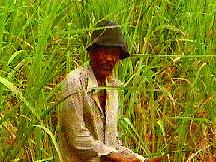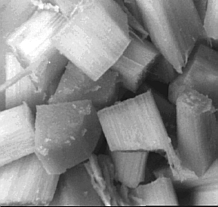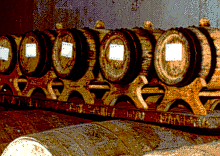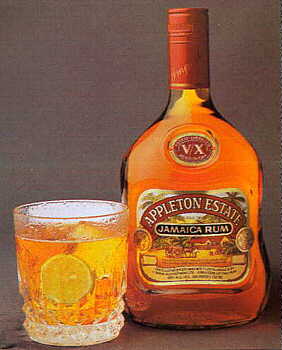

Many people, when thinking about the early days of Jamaica
conjure up images of


The Mona Campus of the UWI in Jamaica, occupies lands that
were part of two large sugar estates: Mona and Papine. Of over
1000 acres at Mona, less than 200 were usually planted in cane.
(2.471 acre = 1 hectare). During the nineteenth century, the
normal yield of sugar would be around 1 hogshead per acre of cane
(1 hogshead was on average 16 cwt) hence 200 hogsheads would be
expected.
It has been calculated that to be economically viable a
plantation needed to produce at least 200 hogshead of sugar and a
few estates in Jamaica managed 600 in a good year.
At Mona however, the average seems to have been more like 80
hogsheads and this low annual yield suggests that the soils had
deficiencies and the remnants of the aqueduct further suggests
that droughts were a problem.
Lady Nugent, in her journal, describes her visit to the Hope Estate on the 1st Oct 1801. She indicated that the Hope Estate produced 320 hogshead of sugar annually and that because of the Hope River running through the property it was not as susceptible to drought as some of the other plantations.
Part of the Hope Estate was acquired by the Government in 1871 to establish the Hope Botanic Gardens which still exists. In addition there are now a number of Government offices and laboratories located there, including the Government Chemist, the Scientific Research Council, the Jamaica Bauxite Institute and the University of Technology.
Rum was an alternative income for the estates to sugar. By 1910, the Mona Estate had only 30 acres in cane and from this came 35 hogsheads of sugar and 30 puncheons (about 200 gallons to the puncheon) of rum. This was insufficient to keep such a large property solvent and soon after the property was sold to the Kingston General Commisioners. This completed their control of the water-rights to the Hope River, previously held by the three separate estates.
The Sugar Industry is the oldest continually operating industry in Jamaica, generating the third largest foreign exchange earnings (after tourism and bauxite--not counting illegal exports!!).
| Factory | Capacity | Production(Tonnes) | ||||||
| (Tonnes) | 2000 | 2001 | 2002 | 2003 | 2004 | 2005 | 2006 | |
| Frome | 90,000 | 59,108 | 64,078 | 56,534 | 53,117 | 56,978 | 42,515 | 46,546 |
| Monymusk | 65,000 | 42,247 | 32,559 | 22,666 | 19,028 | 27,258 | 9,322 | 18,424 |
| Bernard Lodge | 50,000 | 29,325 | 28,193 | 19,673 | 16,798 | 21,869 | 14,053 | 15,124 |
| Appleton | 50,000 | 23,291 | 30,706 | 26,707 | 20,882 | 29,267 | 21,404 | 26,327 |
| Trelawny Sugar | 30,000 | 15,600 | 8,967 | 9,873 | 10,475 | 10,410 | 4,654 | 9,005 |
| St. Thomas Sugar | 25,000 | 13,389 | 10,615 | 10,968 | 9,685 | 13,492 | 10,426 | 10,927 |
| Worthy Park | 26,000 | 25,188 | 22,339 | 23,066 | 22,552 | 24,566 | 21,833 | 20,958 |
| Total | 336,000 | 216,387* | 204,478* | 174,640* | 152,536 | 183,839 | 124,206 | 147,311 |
Sugar is the largest employer of labour, directly employing more than 50,000 workers. Additionally, the industry with its renewable agricultural raw material base, has vast potential for energy generation and establishment of small, high value fermentation and sucrochemical industries.
The processing of sugar cane is one of the vital industries of the country to the extent that small pieces of cane are often found in household refrigerators for chewing. A 1791 pamphlet published in an attempt to get the people of Great Britain to abstain from West Indian sugar and rum so as to abolish the slave trade quotes the following attibuted as Cowper's Negro's Complaint.

The involvement of the Chemistry Department at Mona with the industry began many years ago when the Department organised summer training courses for sugar industry laboratory technicians. Since then, the relationship has grown with the establishment of the Factory Technology Division of the Sugar Industry Research Institute (SIRI) whose laboratories were initially housed in the old Applied Chemistry building on the Mona campus. (From which the first lecture in the University was given in 1948). The Institute utilised both human and physical resources of the Department in its formative years. Courses in Sugar Cane Processing have been offered at various times at the Postgraduate level and a course is currently being offered at the undergraduate level.
Since 1991, the Department has collaborated with SIRI
on a number of research projects funded by the Institute. The
broad areas of interest are:
One possible derivation is from the Latin for sugar saccharum another has been given as..
the name Kill-Devill alias rumbullion was given to the first beverages in Barbados which were notably rough and unpalatable and could "overpower the senses with a single whiff" and were "a hot hellish and terrible liquor".
With time and experience, the manufacturing technique improved and a palatable and wholesome spirit emerged. In Connecticut in 1654 a General Court Order was made to confiscate..
"whatsoever Barbados liquors, commonly called rum, Kill Devill or the like"
Apparently, trade between Barbados and New England, Virginia and Connecticut, led to exchange of rum for products such as salted fish, pork and beef, flour, lumber and livestock.
The present rum refinery at Mount Gay Ltd (St Lucy) is thought to have been in operation as early as 1663.
The Mount Gay Distilleries Ltd in Bridgetown now owns the Mount Gay label and details
on the history of rum in Barbados can be found on their web site at
www.mountgayrum.com
Appleton of Jamaica,
which dates back to 1749, is said to be the world's second oldest
spirit.
The third is St James rum from Martinique, which dates back to
1765.
J. Wray and Nephew Co. Ltd., the largest producer and bottler
of rums and spirits in Jamaica, began in 1825 when John Wray
opened the Shakespeare Tavern on the north side of the city
square in downtown Kingston. The partnership with Charles Ward,
his nephew, began in 1862. Wray and Nephew and the Appleton
Estate and Distillery were linked in 1917 when Wray and Nephew
was purchased by the Lindo Brothers Company who the previous year
had bought the Appleton Estates. They continued using the Wray
and Nephew brand name and in 1996, the company was reported to have
exported over US $20 million worth of products.
| PARISH | 1832 | 1852 | 1897 | 1966 | 1998 | 2006 |
|---|---|---|---|---|---|---|
| St. Andrew | 17 | 7 | 1 | - | - | - |
| St. Thomas | 82 | 47 | 7 | 2 | 1 | 1 |
| St. Mary | 60 | 41 | 2 | 1 | - | - |
| Portland | 46 | 17 | - | - | - | - |
| St. Ann | 32 | 22 | 7 | - | - | - |
| Trelawny | 84 | 62 | 33 | 2 | 2 | 1 |
| St. James | 89 | 56 | 21 | 1 | - | - |
| Hanover | 59 | 41 | 15 | - | - | - |
| Westmoreland | 48 | 40 | 22 | 1 | 1 | 1 |
| St. Elizabeth | 27 | 13 | 3 | 2 | 1 | 1 |
| Clarendon | 70 | 49 | 18 | 3 | 1 | 1 |
| St. Catherine | 56 | 32 | 5 | 5 | 2 | 2 |
| Jamaica | 670 | 427 | 134 | 18 | 8 | 7 |
| Some Early Production Figures from Distilleries in Jamaican Parishes | ||||||||||||
|---|---|---|---|---|---|---|---|---|---|---|---|---|
| Parish | 1893 | 1901 | 1912 | 1922 | 1936 | 1948 | ||||||
| Dist. | Gallons | Dist. | Gallons | Dist. | Gallons | Dist. | Gallons | Dist. | Gallons | Dist. | Gallons | |
| St Andrew | 1 | 10500 | 1 | 7392 | - | - | - | - | - | - | - | - |
| St Thomas | 10 | 102648 | 4 | 56868 | 2 | 41496 | 4 | 109526 | 2 | 65750 | 2 | 295953 |
| St Mary | 4 | 35280 | - | - | - | - | - | - | 1 | 31240 | 1 | EtOH only |
| St Ann | 8 | 76839 | 3 | 57372 | 2 | 32844 | 3 | 6270 | 2 | 39369 | 2 | 52327 |
| Trelawny | 26 | 245574 | 24 | 215948 | 18 | 129234 | 9 | 204242 | 4 | 85330 | 3 | 165678 |
| St James | 25 | 154308 | 20 | 90216 | 8 | 57540 | 7 | 86886 | 4 | 64982 | 4 | 168558 |
| Hanover | 16 | 105672 | 15 | 99540 | 7 | 60312 | 2 | 63570 | 1 | 15225 | 1 | 31447 |
| Westmoreland | 23 | 363972 | 21 | 356496 | 15 | 304164 | 8 | 285588 | 7 | 225264 | 1 | 449264 |
| St Elizabeth | 6 | 48720 | 4 | 35028 | 2 | 43848 | 3 | 54618 | 2 | 71148 | 2 | 186794 |
| Clarendon | 17 | 253008 | 13 | 288120 | 9 | 168420 | 7 | 258937 | 3 | 174488 | 4 | 801032 |
| St Catherine | 12 | 219744 | 5 | 75684 | 3 | 33600 | 5 | 303042 | 3 | 183869 | 5 | 813293 |
| Manchester | - | - | - | - | 1 | 5040 | - | - | - | - | - | - |
| Totals | 148 | 1616265 | 110 | 1282664 | 67 | 876498 | 48 | 1372679 | 29 | 956665 | 25 | 2964346 |


The Jamaican Excise Duty Law, No 73 of 1941 defined rum as
"spirits distilled solely from sugar cane juice, sugar cane
molasses, or the refuse of the sugar cane, at a strength not
exceeding 150% proof spirit".
Rum is produced from
sugar cane by fermentation by yeast. The resultant "wash" has
approximately 6% alcohol which after distillation produces rum as
a clear, colourless liquid with about 80% alcohol and a sharp
taste. White rum is essentially this product diluted to 40%
alcohol. Gold rum requires aging in small (40 gallon) oak
barrels. The process of aging is very complex, involving
evaporation of some of the pungent volatile components, reaction
of the rum with the oak wood and perhaps even the absorption of
oxygen through the barrel to convert some of the alcohol to
aromatic esters.
The total level of flavour components rarely exceeds 1% of the total weight (and is normally much lower) in a base of ethanol. This high concentration of ethanol presents particular problems in both sensory and analytical studies. Furthermore, the advent of gas chromatography has shown that most of the components found in potable spirits are the same and that the nuances of flavour are essentially attributable to small differences in the relative proportions of these components.
Note however that expert tasters have been known to name the district and frequently the actual estate from which the rum originated, just by the sense of taste and flavour.
In Jamaica, gold rum is generally bottled at proof strength
(Imperial) which is 57 Volume % alcohol. (By comparison, 100 US
proof is 50 Volume % alcohol). See
the conversion chart.
| Composition of Rum and American Bourbon Whiskey | ||||
|---|---|---|---|---|
| Jamaican Rum | American Bourbon | |||
| Age (years) | 0 | 3 | 0 | 3 |
| Constituents | Concentration g/100L | Concentration g/100L | ||
| % alcohol | 80.1 | 78.2 | 77.5 | 75.5 |
| total solids (extract) | 0 | 87.6 | 0 | 136 |
| fixed acids | 0.9 | 8.8 | 0 | 12 |
| volatile acids | 1.1 | 20.9 | 3.2 | 50 |
| Total acids | 2.0 (pH=4.9) | 29.7 (pH=4.5) | (3.2) | (62) |
| esters (for years, erroneously called ethers) | 9.7 | 37.5 | 9.6 | 42.0 |
| aldehydes | 1.9 | 4.7 | 0.6 | 5.6 |
| fusel oils (higher alcohols) | 48 | 66 | 250 | 298 |
| furfural | n/d | 1.6 | 0.12 | 1.42 |
| tannins | n/d | 33.0 | 0 | 62 |
n/d= not detected
 Return to Chemistry, UWI-Mona,
Home Page
Return to Chemistry, UWI-Mona,
Home Page
Copyright © 1995-2013 by Robert John Lancashire, all rights reserved.
Created and maintained by Prof. Robert J. Lancashire,